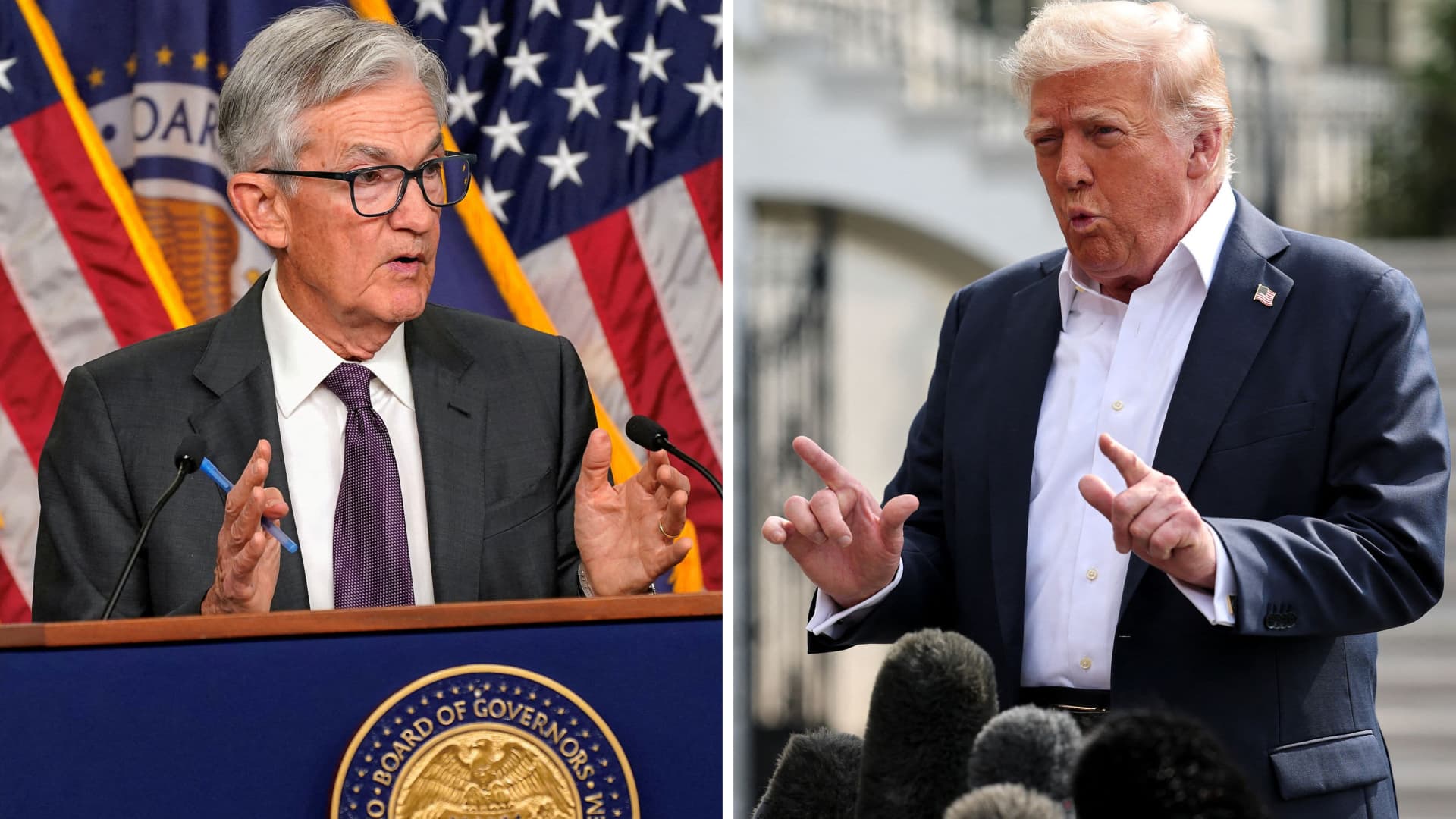U.S. Federal Reserve Chair Jerome Powell, left, and U.S. President Donald Trump.
Nathan Howard | Jonathan Ernst | Reuters
A new research note gaming out possible scenarios if President Donald Trump decides to fire Federal Reserve Chairman Jerome Powell warns that, regardless of what exactly happens next, “this would be a mess.”
“We expect, as does everyone else, that it would be significantly negative for markets, likely driving both an equity selloff and a counterproductive spike in long-term yields,” Wolfe Research‘s Tobin Marcus and Chutong Zhu write in the note to clients.
Wolfe Research speculated that the Supreme Court could ultimately decide whether Trump has the power to fire Powell for cause.
The firm issued the analysis just hours after Powell’s tenure as head of the central bank looked extremely shaky and then abruptly looked less so.
A senior White House official told CNBC earlier Wednesday that Trump had told a group of Republican members of Congress the night before that he likely will fire Powell “soon.”
But during a question-and-answer session in the Oval Office with reporters shortly after the official spoke, Trump quickly and publicly denied what his White House was saying.
“We’re not planning on doing it,” Trump said. “I don’t rule out anything … but I think it’s highly unlikely, unless he has to leave for fraud.”
Trump is notoriously mercurial and has a long track record of firing employees very soon after saying they have his full support.
In Powell’s case, however, Trump has been complaining for months, blasting the Fed chair for not cutting interest rates despite the president’s demand that the central bank do so.
Evercore founder Roger Altman told CNBC’s “Closing Bell” on Wednesday, “There are a lot of bad ideas out there. But the president firing the chairman of the Fed, or, should I say, trying to fire him —because that’s not clear to me at all that he could succeed — that’s among the worst ideas.”
“It’s a dreadful idea,” said Altman, who served as deputy Treasury secretary under former President Bill Clinton.
Altman pointed to what he called a “stark” difference between the economic trajectories of countries that have truly independent central banks, such as the United States, and nations that have “politicized central banks controlled, by example, by their heads of state.”
For the latter, he cited Turkey and Argentina as two examples. Both countries have had double-digit inflation rates in recent years.
Moreover, said Altman, “I don’t think Chairman Powell would accede to a request that he leave” if Trump were to make one.
“So I think, ultimately, this would be resolved in the courts,” Altman said.
The Wolfe Research analysts concurred with Altman’s view.
“If Trump moves to actually fire Powell rather than just pressure him to resign, Powell would presumably sue to stop it,” the Wolfe Research note said.
“The first big question is whether he would, in fact, be de facto fired as litigation proceeds,” the analysts added.
They noted that in several other instances where Trump had fired the commissioners of independent agencies during his second term, those commissioners had filed lawsuits seeking their reinstatement.
“Those lawsuits have failed,” the analysts wrote.
“The wrinkle in this case is that Powell is the head of his agency, unlike the other recent firings at independent agencies, which typically occurred in situations where Trump had already designated a new chair of the agency and was firing non-chair commissioners,” the note said.
“In those cases, the chair could effectuate these firings—but there’s not really anyone at the Fed who can fire Powell,” it said.
The note highlighted three possible scenarios if Trump fires Powell.
In the first, Powell remains the de facto chairman of the Fed while Trump seeks a judicial order to remove him.
In the second, Powell “leaves voluntarily and litigates to be reinstated.”
In the third and most dramatic scenario, Powell tries to remain as chair, and Trump seeks his removal through executive action.
The note says a similar scenario occurred in March when Washington, D.C., police were called to escort employees of the U.S. Institute of Peace out of their building after staff from Elon Musk’s so-called Department of Government Efficiency accused them of trespassing.
“Needless to say, Powell being escorted out of the Fed by either D.C. police or federal law enforcement would be a worrying image for markets,” the Wolfe Research analysts wrote.
If there is litigation over Trump firing Powell, it likely would end up at the Supreme Court. The analysts noted that the majority recently indicated in an unrelated case that “it views the Fed differently from other independent agencies when it comes to for-cause firing protections.”
“The Federal Reserve is a uniquely structured, quasi-private entity that follows in the distinct historical tradition of the First and Second Banks of the United States,” the Supreme Court’s majority wrote in an order allowing Trump to fire officials of two other agencies.
The Wolfe Research analysts said, “We think Powell would have a decent chance to win in court, but it’s far from a sure thing.”
They noted that the question of whether the Supreme Court is willing to maintain “for-cause protections for the Fed chair … is a different question than whether they’re willing to overrule the President on what constitutes cause.”
One scenario postulated in the note is that the Supreme Court would allow a lower court’s injunction blocking Trump from firing Powell to remain in effect while the case over Trump’s authority to fire him plays out.
“That would likely be enough for him to serve out his term as chair,” the note said.


